Chris Grinter By, on February 24th, 2010
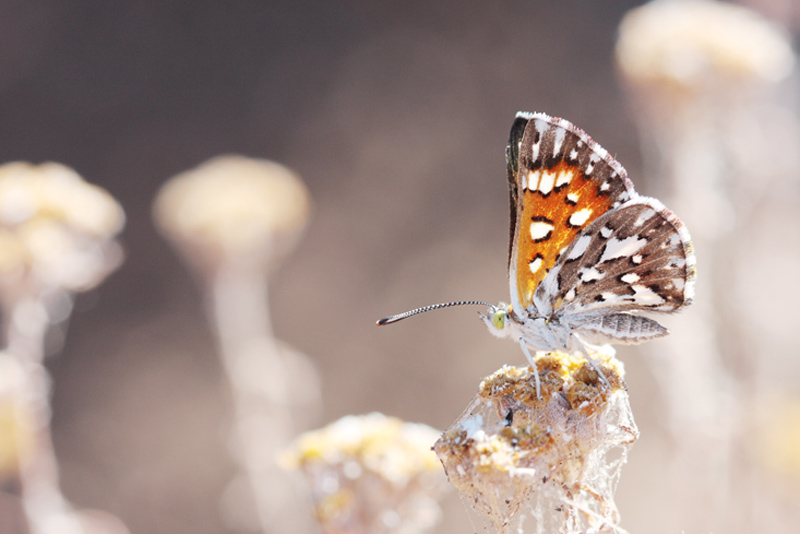
Ezagutu tximeleta hau? Ondo da, inork ez du benetan egiten. Apodemia generokoa da (Riodinidae), baina talde honen taxonomia hondamendia da… eta ez nazazu azpiespeziean hasi ere egin. Ale hau irailean atera zen argazkia, hau da, litekeena da Apodemia mormo izatea (mormoa) hegaldiaren denboran oinarrituta. Batek. mormoa udazkeneko flyer bat da eta Batek. virgulti udaberriko flyer bat da. Forma batzuk bereizgarriak diruditen arren, gainjartze morfologiko masiboa dago eta normalean berdinak eta sinatrikoak dira – Izan ere, landare berdinetan bizitzea. Baina laborategiko esperimentuen arabera, ezinezkoa da pupak diapausa haustea lortzea, beraz, ugalketarako isolatuta geratzen dira.. Beraz, desberdinak dira? Lan molekularra egiten den bitartean epaia atera da, baina badirudi azkenean bi espezie hauek mantendu daitezkeela. Eta, jakina,, mendilerro bakoitzak bere azpiespeziea du. Nork daki, Ziur ez dudala. Pozten naiz tximeleten gainean lan egiten ez dudalako.
Espezie-kontzeptuak lerro lausoak dira eta inoiz ez dago argi non moztu zehatz-mehatz. Espezie bat zer den galdetuta jende gehienak Mayr kontzeptua lehenetsi du Espezie Biologikoak (BSC), non ugaltze isolamendua = berria. Hau dena ondo dago baina kontuan izan behar dugu hau ez dela espezie kontzeptu BAKARRA. Badaude dozenaka, eta bat ere ez da perfektua. Grammia bezalako taldeak (Noctuidae: Arctiinae) hibridazio maila altua erakusten dute, BSCri ondo atxikitzen ez dena. Espezie bat mugatzeko ahalik eta irizpide gehien aplikatzea gustatzen zait eta badirudi lerroa oso meheegia dela intsektuetan. Ezaugarri morfologiko bereizgarri bat ikustea gustatzen zait, hegal-kolorean edo ereduan ez bada, genitaletan edo antenetan behintzat. Hala ere, ez da beti horrela izaten eta biologiari edo/eta DNAri begiratu behar zaio. Helburu guztietarako berdinak diren bi intsektu aztertu ditut. Baina biologia zeharo ezberdina eta handia da % aldea (baino gehiago 8% – bai, arbitrarioa) haien DNAn bereizita daudela zalantzaezina da.
Eta espezieak nahikoa gatazkatsuak ez balira azpiespezieak are gehiago nahastu lapikoa. Eszeptikoa naiz kontzeptu guztiarekin, baina badira kasuak sinesgarri eta beharrezkoa diruditenak. Azpiespezie bat geografiko baten definizio formalagoa da “sits eta intsektuen bilketa” eta normalean beste azpiespezie batean nahasketa-eremu bat erakusten du. Adibidez, begiratzen baduzu 27 desberdinak Plebejus icarioides populazioak alde handiak daude iparraldeko eta hegoaldeko populazioen artean, baina aldea oso sotila gradientean zehar. Gradiente iraunkor hori da espezie dinamiko bat sortzen ordez 27 espezie bereiziak – egungo ikerketen arabera behintzat. Sitsak zortea izan dute eta, orain arte, gehiegizko azpiespeziazioaren izurritea saihestu dute, tximeletak ez hainbeste. Baliteke bildumazale gutiziatsuak Parnasius-en azpiespezie berriak irabazteko asmoz izendatu dituzten kasuak ere (tximeleta azpiespezie arraro berriak diru handien truke saltzen dira).
Egia da espezieen kontzeptuak artifizialak direla, gaizki ulertua eta dinamikoa onenean; okerrenean, egiazko froga aukerarik gabeko zientzia bigun batera hurbiltzen da. Hala ere, espezieak benetakoak dira eta teoriak egokitzen joango dira hemen esertzen garen bitartean buruak urratzen.
Chris Grinter By, otsailaren 23an, 2010 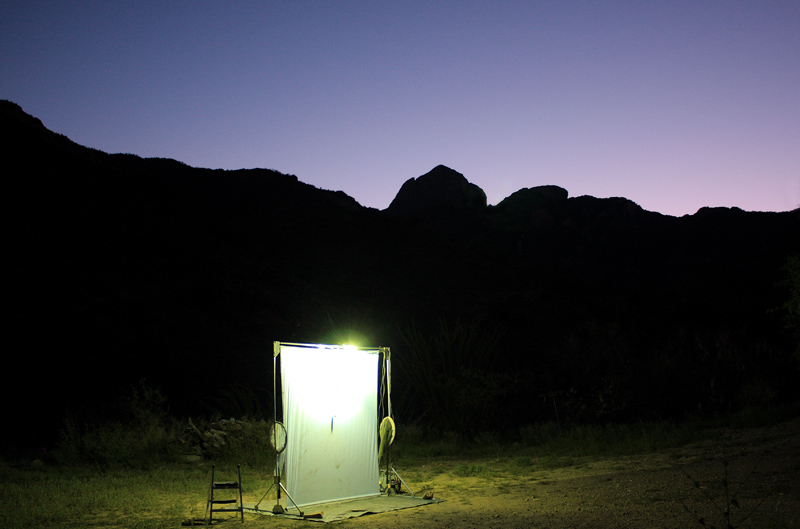
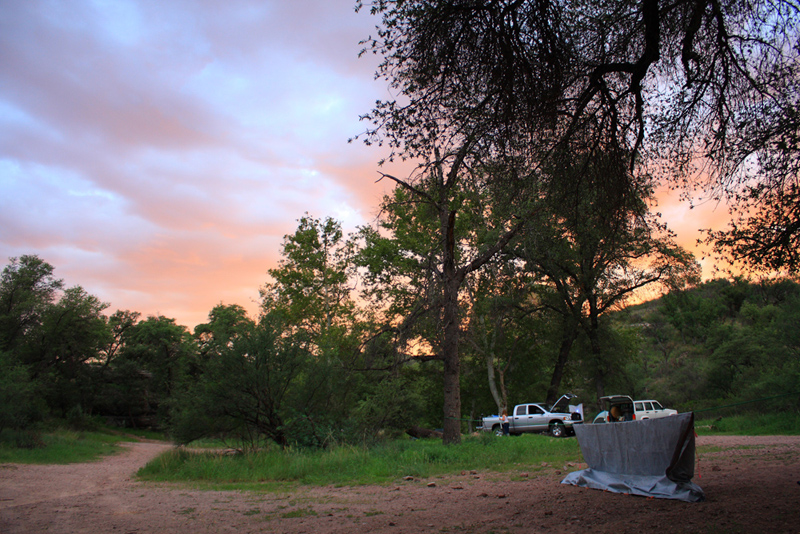
One of the perks of being an entomologist is traveling and collecting. I put a few thousand miles on the car every summer and these are two of the best places in Arizona to collect. The top image is from the Baboquivari Mountains (Baboquivari Peak in the middle), Brown Canyon Research Station. The bottom image is of Pena Blanca Canyon, a famous collecting hotspot. This canyon is just 5 miles from Mexico and has a few safety concerns because of our current immigration policy. One morning, while sorting moths from the previous nights catch, a colleague and I had a group of roughly 30 illegals walk right through our camp. They were well dressed and clean, waved, and must have just been dropped off at the fence. Thankfully the majority of illegals are hard-working and honest people trying to earn a better life. It’s the coyotes and smugglers that are scarier – I have heard tales of Mexican police escorting drug caravans into the US with heavy artillery. And just last year a border patrol agent was stabbed to death by a coyote in this vicinity.
Thankfully, a bunch of strange guys standing around strange lights at nights grants us a wide berth.
(Are these images small enough to load quickly?)
Chris Grinter By, otsailaren 23an, 2010 Nahiko tximeletak desinteresatu izan arren, Nahiko begiratzen dira. Hona hemen bideo benetan handia tipo bat behera ezagutzen dut Hegoaldeko CA hasi da. Bere time-lapse Lepidoptero bizitza zikloen bideoak nahiko ikusgarriak dira, eta da zehazki hura eder. Moztu baduzu buruz 3:00 urtean, Great Purple Hairstreaks dozenaka ikusiko duzu (Atlides halesus) beren chrysalises hasi berri diren, koloreak ikusgarriak dira. Tximeleta hau SW eta Mexikoko autoktonoak, eta hura maite dut, arlo horretan aitortu behar dut.
[youtube=http://www.youtube.com/watch?v=KyWJlpIchkE]
Chris Grinter By, otsailaren 23an, 2010 Linus Pauling eta bitamina C buruzko iruzkin laburra behean egin gogoratzen bideo honetan lehen ago argitaratua berriz batek Pharyngula. Hau da, Kary Mullis, PCR asmatzaile, eta Nobel saridun bat. Bere asmakuntza funtsean egindako DNA analisi posible. Baina Pauling bezala, ere bada guztiz eta erabat intxaurrak. Denboraren entzun zion osteratxo nahi baldin baduzu, tiro bat eman. Baina, azken finean, hogei analizan zuen, berotze globalaren ukatzen eta nola HIESa ez da GIB eragindako. Galdetzen diot nire buruari zer estatistikak jenio zientzialariek beren roquero off lerratu horretarako dira?
[Vimeo 9167379]
Chris Grinter By, on February 22nd, 2010 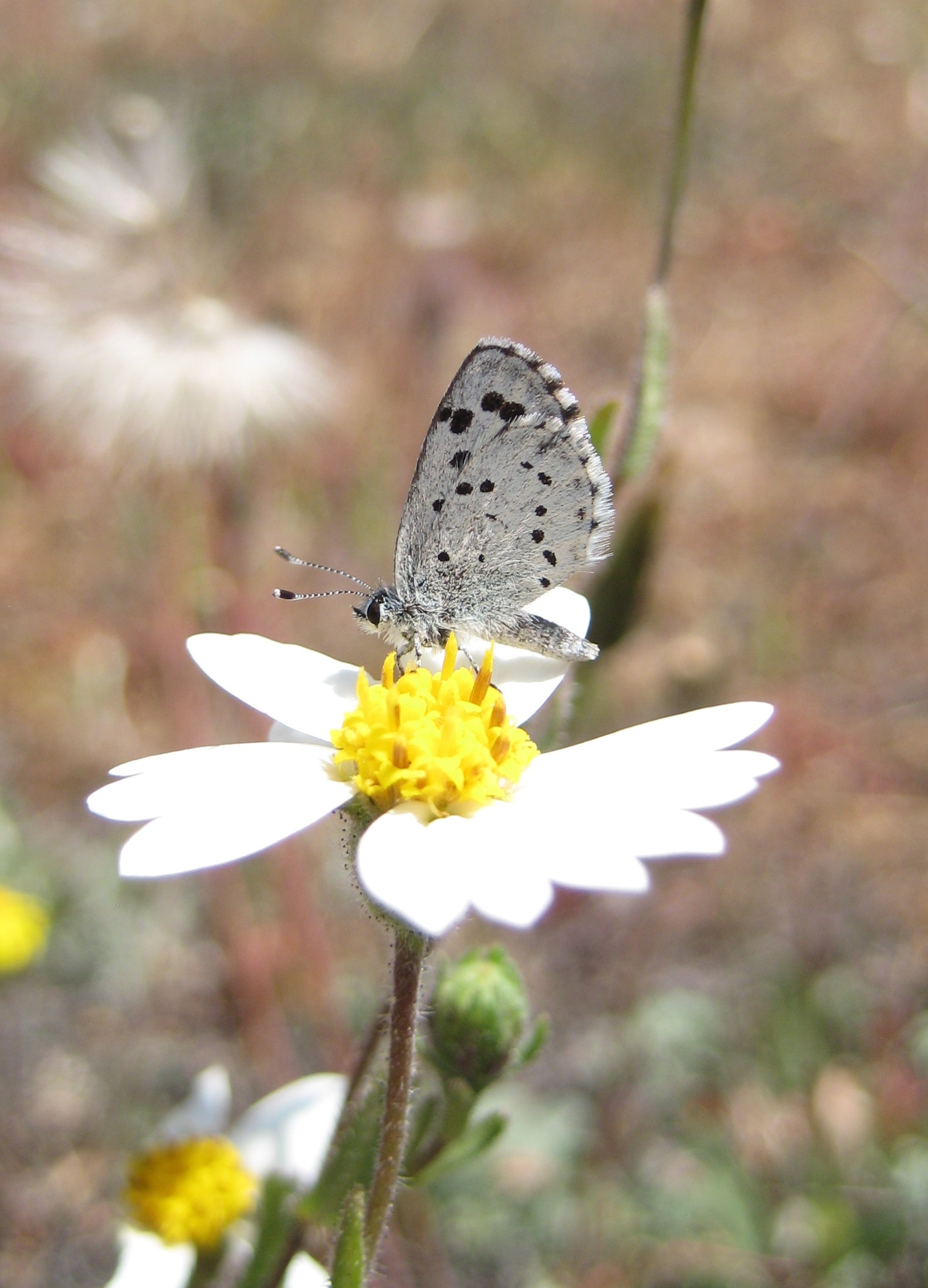
Hau nire irudi zaharra da, beraz, ez da perfektua. Espezieei tximeleta hau esaten badidazu, bost bat lortuko duzu. Azpiespeziea ezagutzen baduzu, pakete berri bat bidaliko dizut #3 altzairu herdoilgaitzezko pinak! Iradokizun bakarra: AEB mendebaldekoa da.
Chris Grinter By, on February 22nd, 2010 Today I found hau article in NY times health – touting the benefits of acupuncture used for depression relief in pregnant women. I have a few problems with the journalist, Shirley S. Wang, failing to remain skeptical in her piece. But this comes as no surprise, so I won’t bother to point out obvious flaws in the media.
I will point out the flaws in the study. Please find the original full text, hemen. So after reading this paper I have come to a few conclusions.
1) Very small sample size of 150 patients, bakarrik 141 treated.
2) The study is blinded ONLY for the depression scoring, not administration of acupuncture. In fact, their release form states “Participants in one of these two groups will receive acupuncture that focuses on depression symptoms and the other treatment will not.” Makes sense, getting a needle shoved in your skin is easy to notice. Beraz, these “randomized and blinded” participants knew what was coming and assumed that any poking was supposed to help their depression. Horrez gain, hau (much better) study has shown that simulated acupuncture with toothpicks works just the same. Careful, this is compelling evidence against the validity of acupuncture – not evidence for the usefulness of stimulated “pressure points”. It is a placebo effect.
3) Study assumes validity of “depression specific” eta “non-specific” acupuncture. Meaning one method of pin sticking somehow cures depression over another. What is this based on? Ai itxaron, they say exactly the exhaustive scientific evidence right here: “patterns of disharmony according to the principles of traditional Chinese medicine”. I’m sorry, please, give me modern medicine over 2,000 year old mythical beliefs. How was the average quality of life and life expectancy for an ancient chinese person? Pretty damn horrible, and I’m sure the average life expectancy did not exceed 35 urteak.
4) Basing depression scores on one administration of the DSM-IV Hamilton Rating Scale. Not being a psychiatrist I can’t speak to the efficacy of these tests. Baina, I will go out on a limb and assume that a stronger baseline for depression should be established before comparing results. The test may be accurate, but why not administer it more than once to reduce noise.
5) Selection of massage as a second control. This is a bad attempt at token skepticism, they even state right off the bat “Massage was conceptualized as a control treatment because, although it improves mood immediately after a session, there is insufficient evidence to support its efficacy as a treatment for depression.” When I design a study I like to look at all known factors that I believe will disprove my hypothesis. Choosing something that you already believe will fail only shows their hand of gross bias.
6) Failure to control for socioeconomic factors. 67% of the participants were white, the majority of which were well-educated. They even go as far as to state in the discussion “Hori dela eta, results might not generalize to specific minority groups that were underrepresented in our sample”. Is it just me, or does this statement negate the entirety of their research? They are freely admitting that acupuncture might not work as well in other minority groups. Why could this be? The only logical and scientific answer is that a placebo effect differs across socioeconomic boundaries. If, azken finean, acupuncture was a legitimate medical science, there would be an insignificant difference seen across physiologically identical organisms.
This study is appallingly bad science. These researchers are beginning with the premise that acupuncture works, and searching for data to support their claims. This is exactly opposite of how to conduct real science. Eta, our health reporter at the NY Times didn’t even bat an eye. Fail for you Mrs. Wang, and fail to the NY Times.
Chris Grinter By, on February 21st, 2010 I love Ming Tsai and his cooking empire as much as the next 3-am TV viewer. Benetan, his recipes are fantastic and you should make them yourself. But I have noticed an odd tendency for him to say (paraphrased) “you should always use organic, it’s much better for you”. This leaves me a bit puzzled. What exactly does he mean? Ming is well-educated and this is not anything he should be solely responsible for, but he echoes an all too common misconception that organic is actually better. By better I am interpreting this as healthier, which seems to be a logical gap to bridge. Beraz, let’s look at the data.
A recent and comprehensive review published in the American Journal of Clinical Nutrition has largely convinced me of what I was always skeptical of; that organic foods can not actually be healthier for you. In their breakdown they cited 55 studies and came to the conclusion that “there is no evidence of a difference in nutrient quality between organically and conventionally produced foodstuffs”.
So what is the harm? My problem with all of this is that it is based on the naturalistic fallacy, that “natural” edo “organic” somehow means that the product is safer or healthier. How many times do you see the term “natural” in the store and never give it second thought? If natural things really were safer then traditional Ayurvedic medicines would not be horribly toxic. Afterall, arsenic, lead and mercury are NATURAL – but they are also some of the most toxic compounds known to man. In the end it is 100% marketing.
Taken from another angle Ming Tsai may not be all that incorrect afterall. I do not have all the data in front of me regarding pesticide contamination of foodstuffs, but it is logical to assume the less contaminated the better. Obviously pesticides can be a bad thing, there are mountains of literature to support the damage they can cause. But the jury seems out on exactly how bad, if at all, these minute residues on our foods are. Conventionally grown foods have regulated levels of residues, but even organics are not free of pesticide contamination. So I look at it differently. Our environment benefits from having safer food. Less chemicals are dumped into our waterways, farmers have to battle less with incredibly powerful toxins, eta blinky the fish fights to see another day. We should all strive to live sustainably and organic farming does provide us with an edge.
So once again, what is the harm? People who buy organic quite possibly do so based on genuine environmental stewardship. I would also argue that a very high percentage of these people also believe these foods are healthier (anyone have survey data to support this claim?). So in this instance the result is a net positive. Baina, being right for the wrong reasons should never be acceptable. This strikes at the peak of a larger problem that is driven by marketing and zero science. Case in point – Vitamin C as a cold remedy. A study in PLOS medicine has shown there is no indication for efficacy of VitC against the common cold. Go figure, a once believed to be true staple has begun to be picked apart by science and data. Let’s be careful on what bandwagon we jump and why.
Chris Grinter By, on February 21st, 2010 [youtube=http://www.youtube.com/watch?v=zSgiXGELjbc]
I really enjoy this autotuned Sagan, makes me with I was this eloquent. Watch more videos here at the Symphony of Science.
Chris Grinter By, on February 21st, 2010 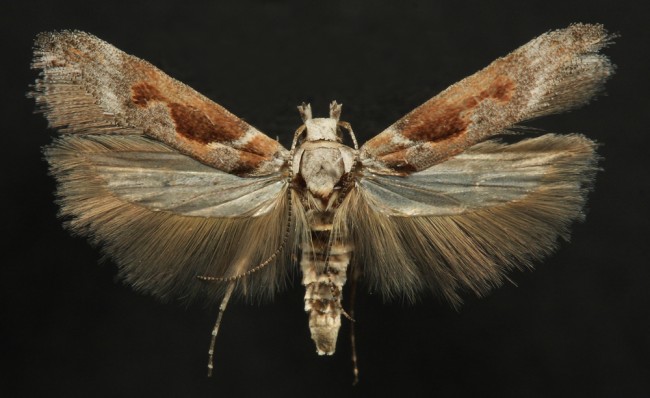 Beraz, how do I begin a new blog? Tough question, but perhaps this is a good time to show off a fun new species. This moth was collected last year outside of Santa Barbara, beraz, ezin dut esan. The massive wingspan, at 15mm, makes it pretty large for a Gelechiid moth. The genus, Gnorimoschema (pronounced nor-a-mosh-ma), seems to be far more species rich than is currently known, so this creature comes as no surprise. It also gives me a chance to brag about the benefits of studying such a wonderfully diverse group of animals. If you happen to be lucky enough to be a friend of mine you’ll probably get your own species at some point. Beraz, how do I begin a new blog? Tough question, but perhaps this is a good time to show off a fun new species. This moth was collected last year outside of Santa Barbara, beraz, ezin dut esan. The massive wingspan, at 15mm, makes it pretty large for a Gelechiid moth. The genus, Gnorimoschema (pronounced nor-a-mosh-ma), seems to be far more species rich than is currently known, so this creature comes as no surprise. It also gives me a chance to brag about the benefits of studying such a wonderfully diverse group of animals. If you happen to be lucky enough to be a friend of mine you’ll probably get your own species at some point.
Bestalde, this also highlights the problem – knowing almost nothing about the most diverse group of animals on our planet. What happens when a new crop is being eaten by a tiny, nondescript, Sits? Call one of the dozen people in the world who might be able to help you. Maybe they know what it is, but likely nothing is known about its biology. This is what happened in South Dakota recently when biofuel crops were being eaten by a moth last seen in 1910. What a perfect reason for more funding! More likely than not my new moth above will never explode into a pest. But having basic knowledge of the species that share this earth with us is a step in the right direction.
|
eszeptizismoa
|





